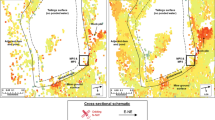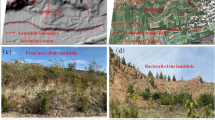Abstract
In avalanche modelling and control and in avalanche forecasting, most of the knowledge is based on scientific theory but the experience of specialists (field practitioners, forecasters...) plays a large role. This paper presents two French computer-based systems dedicated to avalanche modelling and control and to avalanche forecasting. They are both based on expert knowledge. ELSA (Etude et Limites de Sites d'Avalanches), is a computer system dedicated to the modelling of the knowledge of avalanche experts and to theintegration of new symbolic computer models with classical numerical models. The basic aim of integration is to build a unique computer system incorporating all these models. After a description of the terrain representation, we present the different scenarios that ELSA takes into account. Then, the methods which deal with some phenomena occurring in avalanches are described. The problems involved in the integration of these methods close this first part. MEPRA is an expert system built to create an objective tool in avalanche risk forecasting. This development allowed us to imagine a processing system for 2 of the most important problems in avalanche risk forecasting: representation of the present snow cover characteristics and evaluation of avalanche instability and risk. In this way, mechanics and thermodynamics play a major role in the system. After a punctual validation at the location of a snow weather station and in order to describe the great variability of the snow pack and the avalanche risk in a massif, the MEPRA expert system was connected with a meteorological analysis system, SAFRAN and a numerical model to simulate the snow cover CROCUS. Then, every day, a MEPRA expert analysis is carried out in different locations with different orientations, slopes and altitudes. Its results were used successfully during the Winter Olympic Games of Albertville and by avalanche forecasters during the 92/93 winter season. The daily avalanche risks estimated by MEPRA are also compared with the observed avalanche activity during the 10 last winters. For a better description of local phenomena like wind slab or snow accumulation, a local version of this tool should be developed to integrate field characteristics.
Similar content being viewed by others
References
Bakkehøi, S., Cheng, T., Domaas, U., Lied, K., Perla, R. and Schieldrop, B.: 1981, ‘On the computation of parameters that model snow avalanche motion’,Canadian Geotechnical Journal 18, 121–130.
Beghin, P. and Brugnot, G.: 1983, ‘Contribution of theoretical and experimental results to powdersnow avalanche dynamics’,Cold Regions Science and Technology 8, 66–73.
Brandstätter, W., Wieser, K. and Schaffhauser, H.: 1992,Three-dimensional simulation of powder avalanches, to be published.
Brugnot, G. and Vila, J. P.: 1985, ‘Investigation théorique et expérimentale des caractéristiques dynamiques des avalanches de neige dense’,La Houille Blanche 2, 133–142.
Brun, E., David, P., Sudul, M. and Brunot, G.: 1992, ‘A numerical model to simulate snow cover stratigraphy for operational avalanche forecasting’,J. of Glaciol. 38 (128), 13–22.
Buisson, L. and Charlier, C.: 1989, ‘Avalanche starting zone analysis with a knowledge-based system’,Ann. Glaciol. 13, 27–30.
Buisson, L.: unpublished, ‘Le raisonnement spatial dans les systèmes à base de connaissances; application à l'analyse de sites avalancheux’, Thèse d'Informatique, Université Joseph Fourier, Grenoble, 1990a.
Buisson, L.: 1990b, ‘ELSA: a problem solving environment for avalanche path analysis’, in A. Pavé and G.C. Vansteenkiste (eds.),Artificial intelligence in numerical and symbolic simulation, ALEAS, Lyon, pp. 25–50.
Durand, Y., Brun, E., Mérindol, L., Guyomarc'h, G., Lesaffre, B. and Martin, E.: 1993, ‘A meteorological estimation of relevant parameters for snow models’,Ann. Glaciol. 18, 65–71.
Föhn, P. and Meister, R.: 1983, ‘Distribution of snow drifts on ridge slopes: measurements and theoretical approximations’,Ann. Glaciol. 4, 52–57.
Giraud, G.: 1992, ‘MEPRA: an expert system for avalanche risk forecasting’,Proceedings of the International snow science workshop, 4–8 oct 1992, Breckenridge, Colorado, USA, pp. 97–106.
Giraud, G.et al.: 1986, ‘Skill evaluation of avalanche risk forecasting’,Proceedings of the International Symposium of Davos, Sept. 1986. IAHS Pub., n° 162, 1987, pp. 583–591.
Guyomarc'h, G. and Castelle, T.: 1992, ‘A study of wind drift snow phenomena on an alpine site’,Proceedings of the International snow science workshop, 4–8 oct 1992, Breckenridge, Colorado, USA, pp. 57–67.
Guyomarc'h, G., Mérindol, L., Castelle, T., Sivardière, F. and Buisson, L.: 1994, ‘Blowing snow and avalanches’,Proceedings of the International snow science workshop, Nov. 1994, Snowbird, Utah, USA, to be published.
Ilog, S. A.: 1991,Le-Lisp de l'INRIA, Version 15.24, Le manuel de référence, Gentilly.
Ilog, S. A.: 1992,Aïda, Version 1.54, Reference Manual, Gentilly.
Martinet, G.: unpublished, ‘Contribution à la modélisation numérique des avalanches de neige dense et des laves torrentielles’, Thèse de Mécanique, Université Joseph Fourier, Grenoble, 1992.
Meister, R.: 1989, ‘Influence of strong winds on snow distribution and avalanche activity‘,Ann. Glaciol. 13, 195–201.
Norem, H., Irgens, F. and Schieldrop, E.: 1989, ‘Simulation of snow-avalanche flow in run-out zones’,Ann. Glaciol. 13, 218–225.
Rapin, F.: unpublished, ‘Utilisation du programme de calcul d'avalanche à aérosol’, Document Interne, Division Nivologie, CEMAGREF, 1991.
Rechenmann, F., Fontanille, P. and Uvietta, P.: unpublished,Shirka: manuel d'utilisation, Document interne, IRIMAG, 1992.
Salm, B., Burkard, A. and Gubler, H.: 1990, ‘Berechnung von Fliesslawinen; eine Anleitung für Praktiker mit Beispielen’,Mitteilungen des Eidgenössischen Instituts für Schnee- und Lawinenforschung, 47.
Vila, J. P.: 1984, ‘Modélisation mathématique et simulation numérique d'écoulements à surface libre’,La Houille Blanche 6/7.
Author information
Authors and Affiliations
Rights and permissions
About this article
Cite this article
Buisson, L., Giraud, G. Two examples of expert knowledge based system for avalanche forecasting and protection. Surv Geophys 16, 603–619 (1995). https://doi.org/10.1007/BF00665742
Issue Date:
DOI: https://doi.org/10.1007/BF00665742




